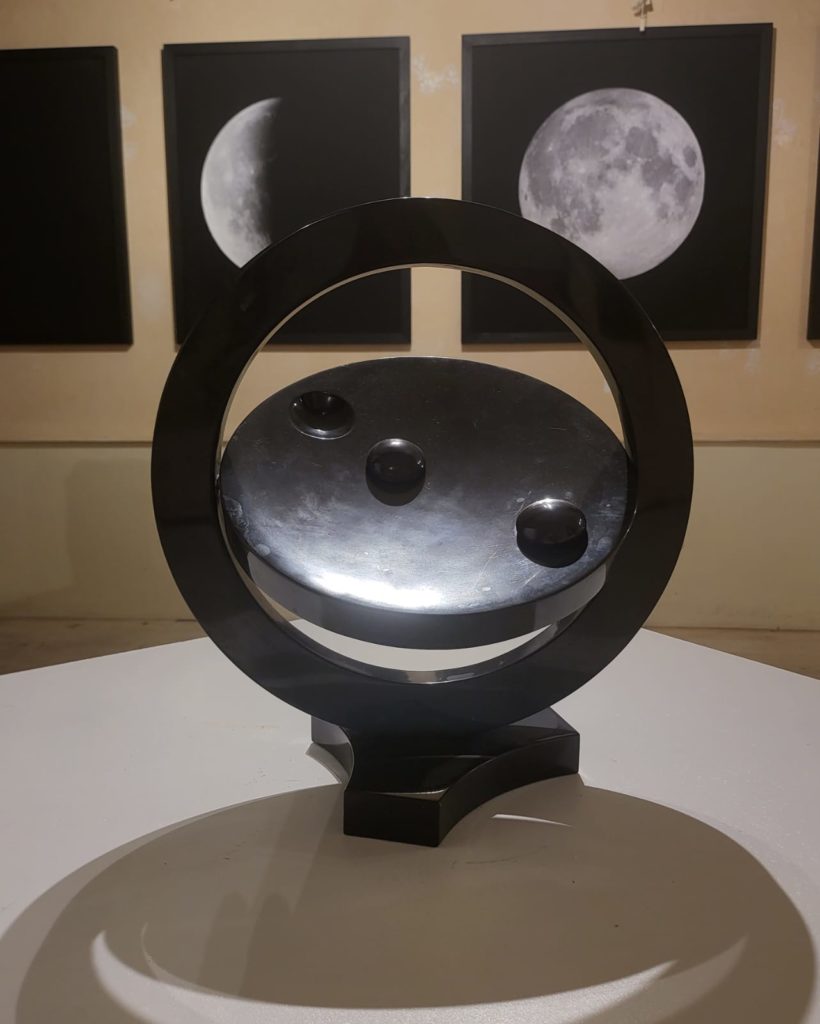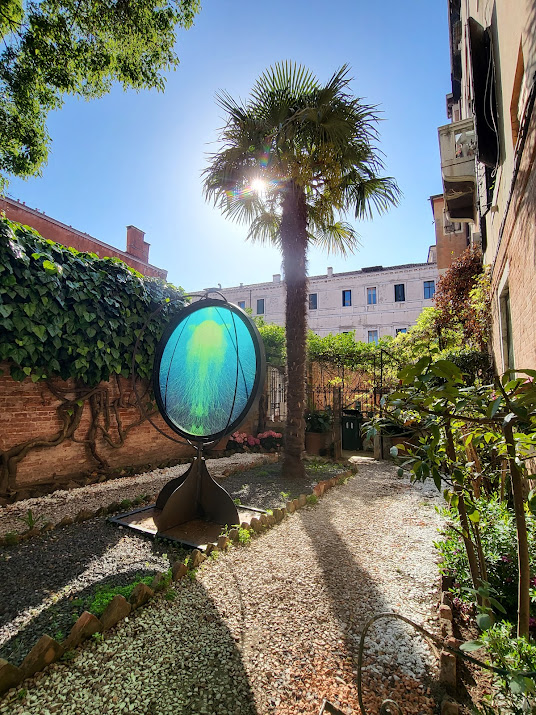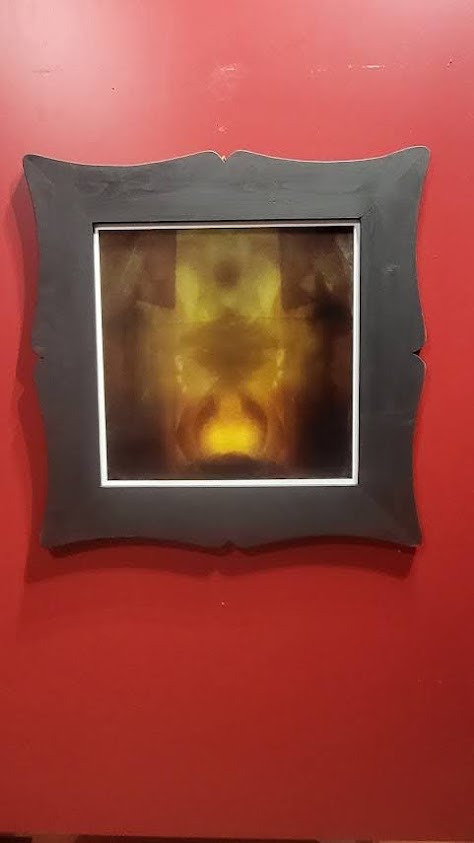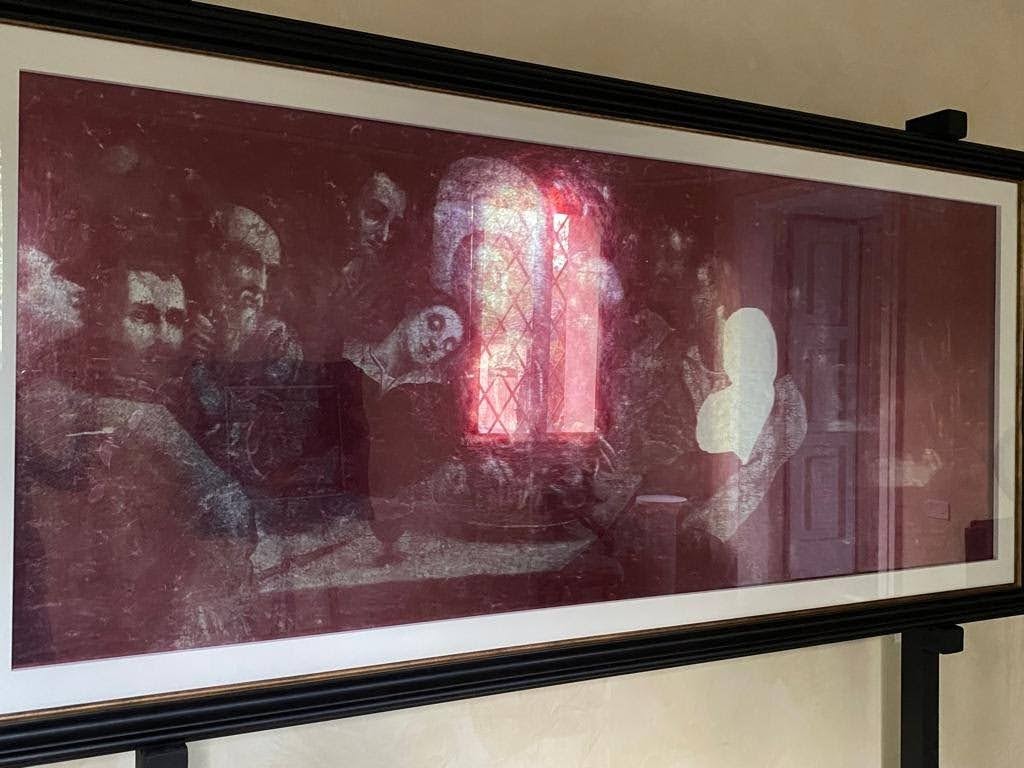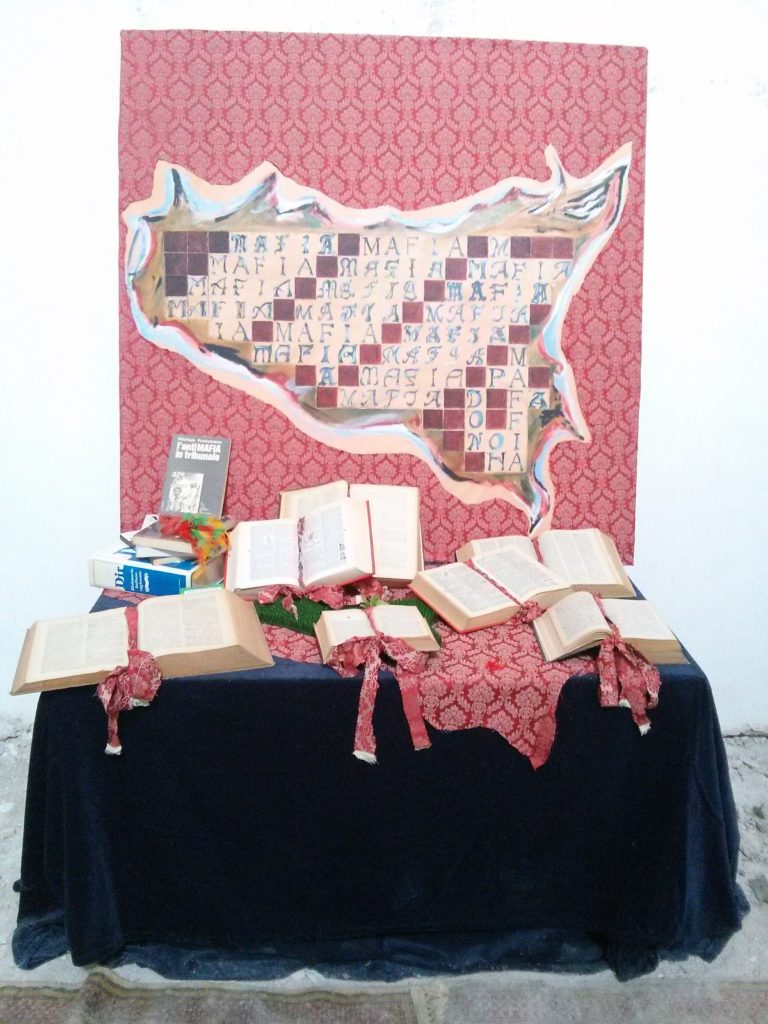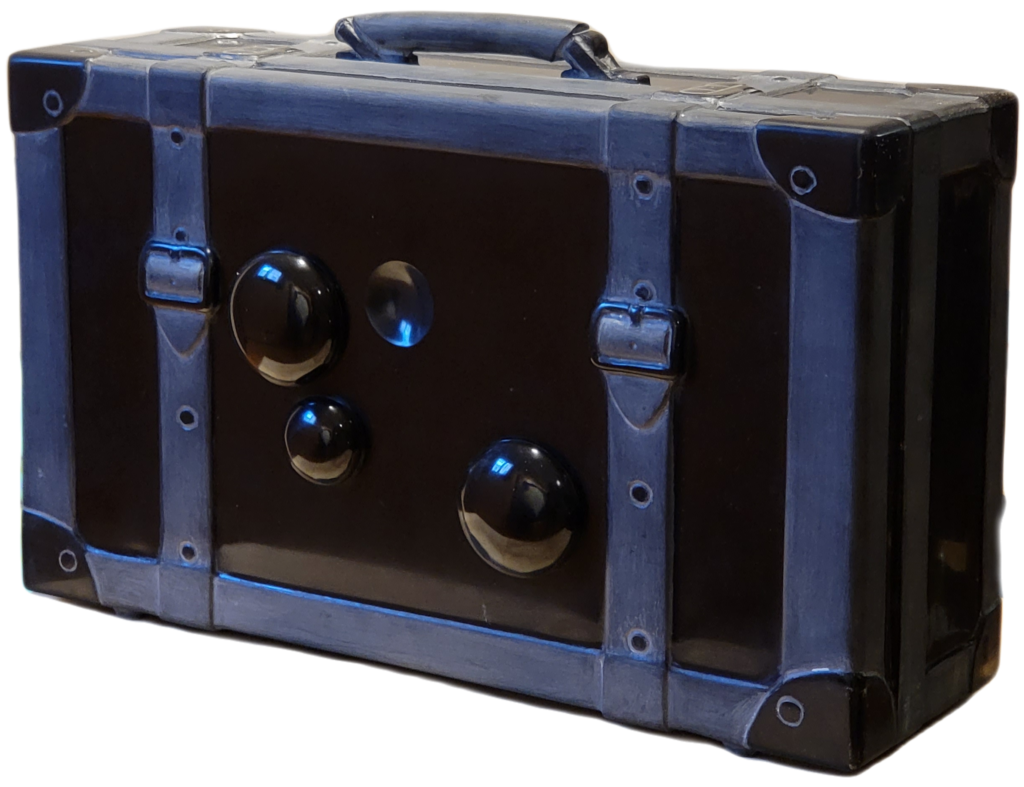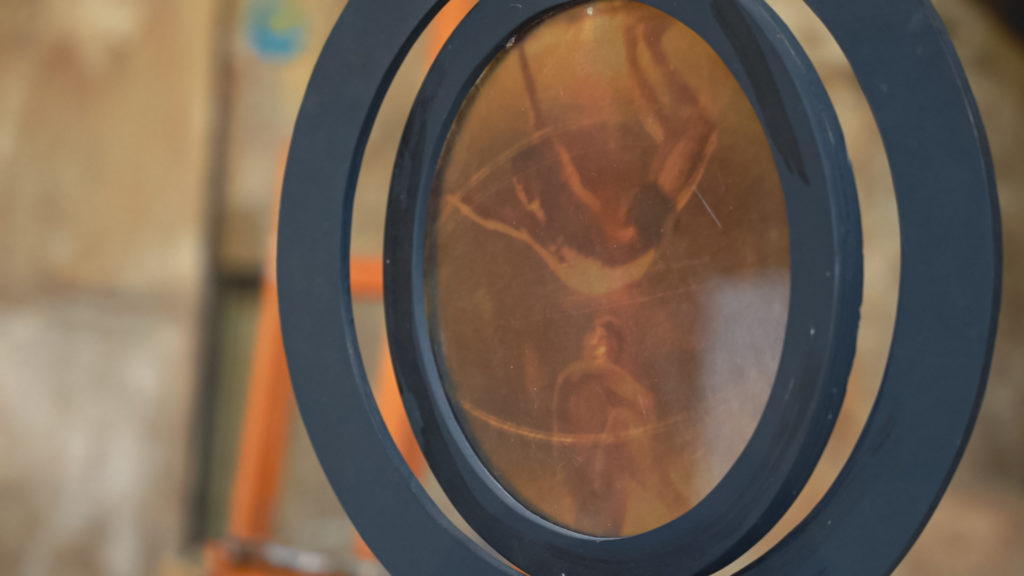Rosa Mundi is an artist’s pseudonym. Born coinciding with the coordinates 5°26’23” North 12°19’55” East, Rosa Mundi lives between two sea islands and an island of smoke. She attends courses in Painting, Sculpture, Choreography and Art History at the Academy of Fine Arts in Venice, the Academy of Fine Arts in Strasbourg and the Ecole Martenot in Paris. An introspective investigator of past and present civilizations, Rosa Mundi transposes real events of everyday life and human feelings into art, creating ad hoc scenarios and performances and then reinterpreting them, giving life to her personal Theater of the World. Rosa Mundi developed her lei technique, dipping the brush in natural plant pigments and organic blends with olive oil, eggs and jellyfish extract. She has always preferred the use of recycled material, with the aim of giving it new life, carrying out a sort of metamorphosis. Her works are characterized by a study of light and reflections. It is present in important public and private permanent collections including the Sicilian Region Contemporary Art Museum, Nieuwmarkt Amsterdam Municipality, Orestiadi Foundation, Museum of Mediterranean Textures, Genzini Collection, Aldo Cichero Design, CANIFF Chic & Cool Canadian, Wopart Exhibition Work , Palazzo Marchetti, Ati Yoga International Foundation, ABI-Italian Banks Association.
He has participated in numerous international exhibitions including he was a finalist at the Cyprus Larnaca Biennale 2023, Venice Art Biennale 2022 State Pavilion of San Marino, Venice Architecture Biennale 2016 selection of the Polytechnic of Turin, Helsinki Pixelate Biennale 2016, Trieste Donna Biennale 2017, Biennale del Sale 2017 in Petralia Soprana, PAW Palermo Art Week End at Palazzo Mazzarino Berlingeri in 2021, Wopart Exhibition Work in Lugano in 2021, CANIFF Chic & Cool Canadian International Fashion Film Testimonial in 2021; Pitti Fashion and Art SSEINSE in 2020, Festival delle Filosofe 2020-2021; Open ateliers Nieuwmarkt Amsterdam Municipality in 2018, Cairotronic Biennial in 2016 and 2018, in Egypt, Biennial of Contemporary Sacred Art in 2016, 2018 and 2020, ABI Italian Bank Associations Exhibition; UNESCO DESS Collective.
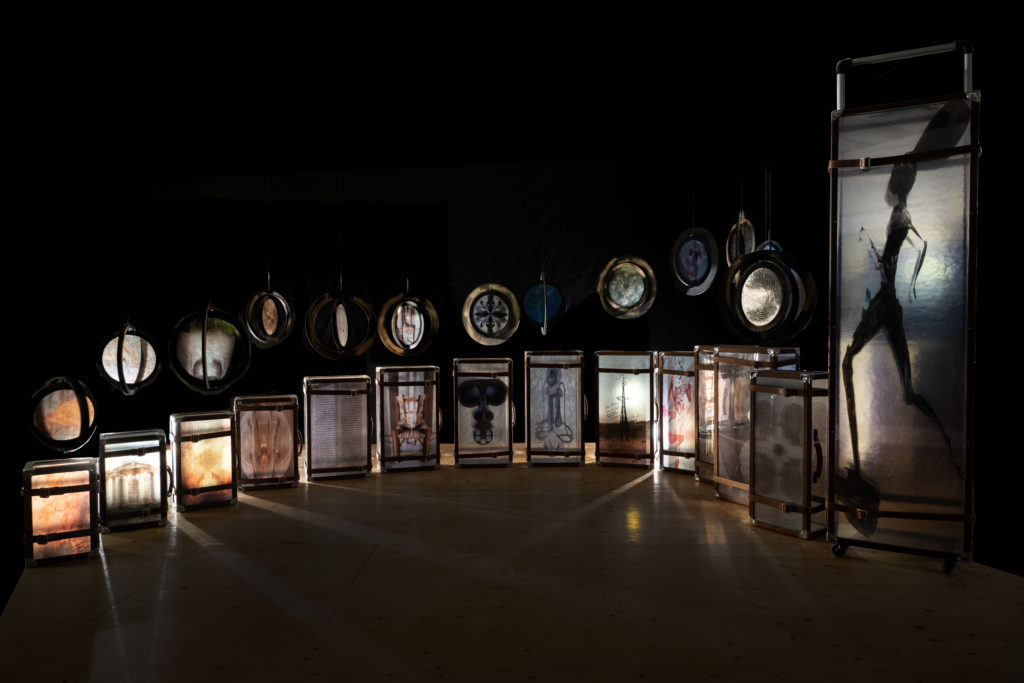
Rosa Mundi has also been the set designer of numerous musical and equestrian theatrical works including the theatrical piece with the Esoskeletri company directed by the director Sasà Neri in “Judas the Guess” in 2018 in the Tindari theater and in Marsala at the Lilibeo Museum, in 2019 in Umbria in the theater of the cities of Amelia and the Teatro Equestre opera “The time of game: Traveling with Ulysses” with performers such as Mario Bajardi, Salvo Piparo, Giuseppe Cimarosa and Michele Piccione in 2020, “The night of living archeology ” at the Archaeological Park of Selinunte in 2023. His works have been used for numerous film sets, from the “New Pope” series directed by Sorrentino to “Non milascia” directed by Ciro Visco, for Prime Video’s “007: Road To A Million ” as well as numerous fashion and art photo shoots.
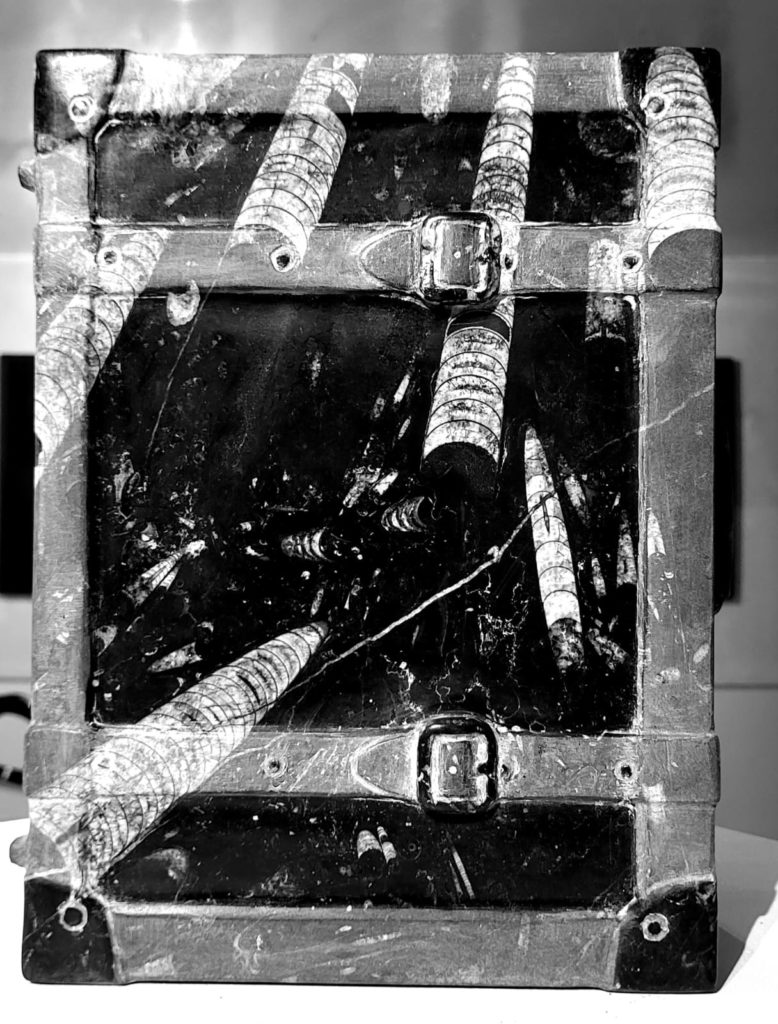
Rosa Mundi has developed numerous techniques in which three-dimensionality or mere two-dimensionality is not given by photographic or computerized techniques but by the search for the infinite space within the work and the work’s ability to recreate and reproduce itself in close connection with the place in which is placed and for which it is designed. But there is more, the pact between Rosa Mundi and the collector, hidden in the fibers of the work.
Fontana’s spatial concept lives again and nests in the works of Rosa Mundi. In 1993 he created his artistic current called “Neo symbo-spatialism“, a union between the classic themes and concepts of the classic currents and archetypes of the artists of the currents of symbolism and spatialism. In this continuous evolution of her art and research, Rosa Mundi combines vegetal and marine animal pigments at the boundaries of oil painting and photography, to the point of operating more in this last period in the processing of marble and stone with glass and the plastic he calls “recycled material”. His aim was to make marble soft, mobile and light, indestructible and heavy as a boulder, ideally, glass.
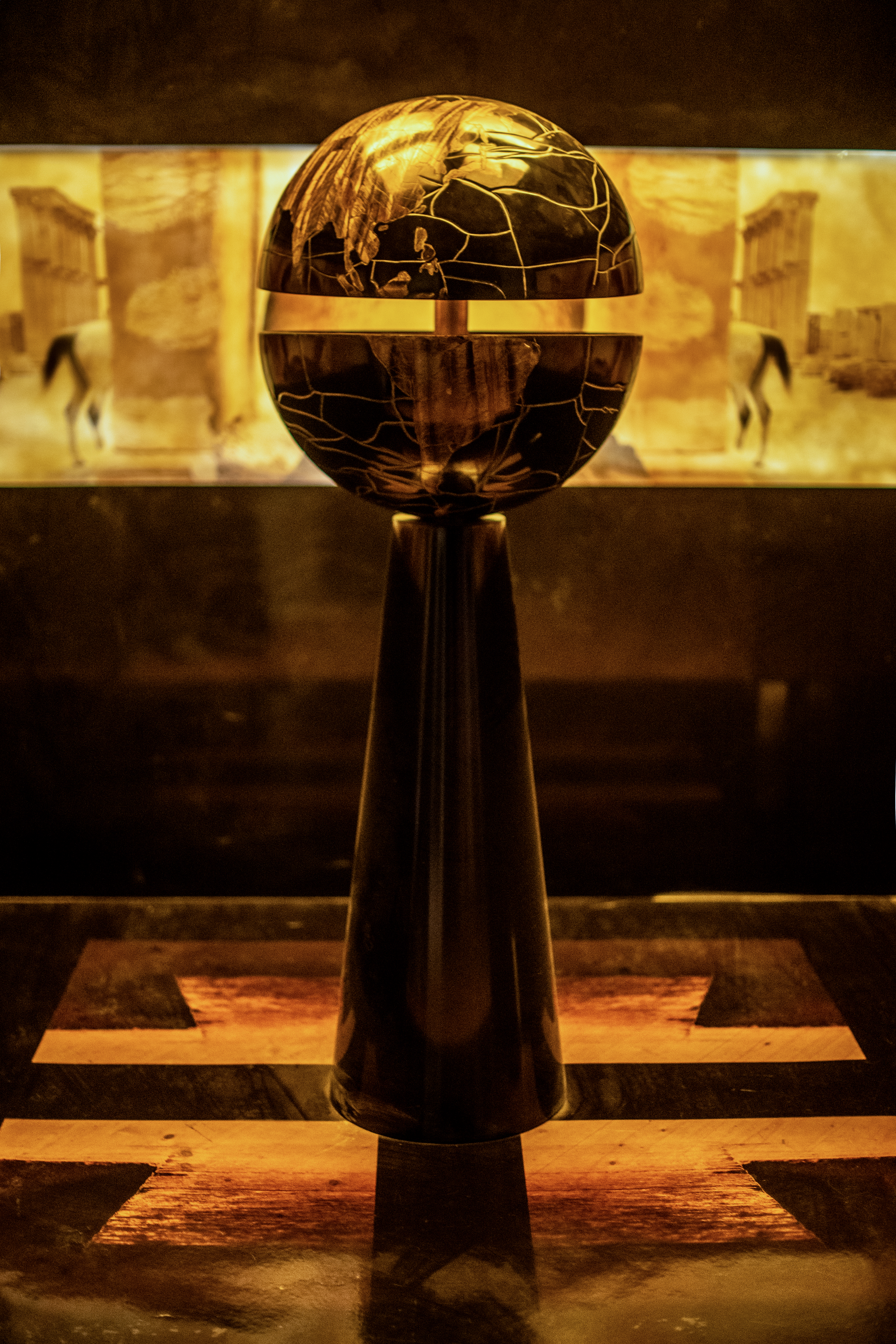
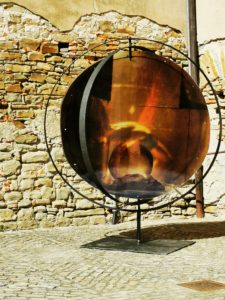
Rosa Mundi’s works evoke a “non-place” by recreating the philosophical essence of his reflections in the transparencies of glass, without ever giving in to mere conceptualism. Rosa Mundi looks at philosophy by decoding it into reflected images that intersect and embrace each other. The key to the work is partly manifest, a hidden abode in the pact between Rosa Mundi and the collector, the patron, the one who chooses his work.
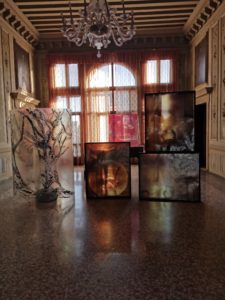
She has been involved in art and photography for more than twenty years, a tireless traveler, she prefers to transpose real everyday events and environmental phenomenologies into art and artistic phenomena. Her workshop path starts from photography, reinterpreting reality and the imaginary in a constant imaginative dialogue, to move on to video productions and mixed manufacturing and installations of glass, fabric, iron, steel and wooden structures. She attends courses in Painting, Sculpture, Choreography and Art History at the Academy of Fine Arts in Venice, the Academie des Beaux Arts in Strasburg, the Ecole Martenot in Paris. From 1992 to today he has exhibited in Amsterdam, Strasbourg, Venice, Paris, Deauville, Vimoutiers, Canapville, Neuilly sur Seine, Cairo, Nuweba, Ras Saitan, Messina, Tindari, Selinunte, Taormina, Palermo, Salemi, Castelporrona (Grosseto), Montecarlo (Lucca), Siena.
In 2016 she was selected by the Polytechnic of Turin to exhibit in the Thetis art space at the 2016 Venice International Architecture Biennale at the Arsenale from May to November 2016 in the Gang City exhibition with her work Lupara al Borotalco. You also participate in the 2011 Venice Biennale of Contemporary Art.
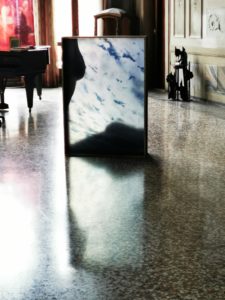
Also in 2016, Rosa Mundi completes a major project written in 2009, namely a major interdisciplinary performance called BIAS – between Venice and Palermo – involving more than 77 artists from all over the world in the innovative concept of a transnational art biennial focused on spirituality of the artist, instead of the nationality or language he speaks. She exhibits at the RISO Museum – Palazzo Belmonte, in the Cathedral of Palermo, at Palazzo delle Aquile and in the Church of the Teatini. The BIAS (www.biasinstitute.it) is a biennial event that takes place mainly in Sicily, an island that the artist has chosen among his main inspiring lands and then opens up to many other places and historical cities between Europe, Asia, the East, Africa in the weeks following the inauguration.
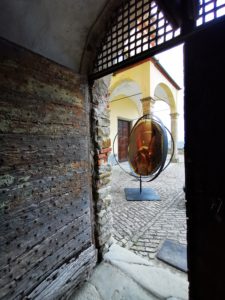
ROSA MUNDI ARTIST
THE MOST EXHIBITIONS
2023 | PARTCOURS 12 | L’art dans la cité DAKAR | Senegal | Loman Gallery residenza d’artista ed esposizione
2023 | MUSA – Museo della Reggia dei Portici a cura di Michele Citro ed Andrea Guastella
2023 | Roma Art Week a cura di Massimo Scaringella- Palazzo Altieri
2023 | Larnaca Biennale Arte Cipro a cura di Yev Kravt
2023 | Scenografia per festa YPO a Venezia- Biennale Cinema
2023 | Scenografia ‘700 per Festa di Carnevale Palio srl &America
2023 | Scenografia “The Doge Venice Red Carpet” per Festival del Cinema Venezia – Fondazione Donà dalle Rose
2023 | Scenografia Tempio di Era nel Parco Archeologico di Selinunte per The look of the Year Italia
2023 | “Feauturing the sculpture habitat” presso Museo Acquario Romano “Acquaria città invisibili” a cura di Fulvio Meroli ed Andrea Guastella
2023 | Banksy e Rosa Mundi “Il Bestiario nel Roseto” Palazzo Donà dalle Rose (VE)/Villa Barbarigo di Valsanzibio (PD)
2023 | Scenografia con installazioni di Rosa Mundi Cinema per la Rai “Noi siamo leggenda”
2022 | 2023 “4Aorund” Palazzo Duchi di Santo Stefano | Fondazione Mazzullo | Taormina
2022 | 2023 “Under the Red Sky” Rosa Mundi e Banksy | Galleria San Babila | Milano
2022 | Digital Week | Fondazione Edison | | Milano
2022 | Opera di Rosa Mundi come Premio al Festival del Cinema di Venezia
2022 | Posologia Umana | Banksy e Rosa Mundi | Palazzo Donà dalle Rose | Venezia
2022 | Postumano. Reliquie in viaggio | Museo Diocesano Francesco Gonzaga | Mantova
2022 | Forest Lux – Castello di Donna Fugata – Siracusa
2022 | Pavilion San Marino Repubblica Biennale Arte Venezia
2022 | Relique in viaggio | Mantova/ Venezia motonavi mostra collettiva
2021 | FOREST LUX Mostra Personale Museo Arte Contemporanea Regione Sicilia | Palazzo Belmonte Riso Palermo
2022 | The trasparency of the sound: the dance of the jellyfish” Museo Kiosk dell’Accademia Belle Arti di Gand, Belgio a cura di Simon Delobel
2021 |Esposizione PAW – Palermo Art Week End 2021 a cura di Maria Ambramencko presso la collezione Berlingeri a Palazzo Mazzarino, Via Maqueda Palermo
2021 |Opere di Rosa Mundi entrano nella Collezione Museale Fondazione Orestiadi Museo
delle Trame Mediterranee Gibellina Nuova Baglio di Stefano: “The day after Tomorrow”, “Il Cretto di Burri”, la II°Sfera Armillare “Humanity’s condition”.
2021 | Espone la XXI Sfera Armillare a Palazzo Zanca, Municipio di Messina, in occasione del 450° della Battaglia di Lepanto con l’opera “La chiave del golfo”.
2021 | Settimana della Moda Milano Fashion Week | Jenny Monteiro e gioielli Jewes
2021 | Festival del Cinema di Venezia | CANIFF Chic & Cool Canadian International Fashion Film
Testimonial Guest Artist UNICEF Sant’Elena Fuori Festival e Hotel Hilton Mulino Stucky Performance di Rosa Mundi con Marck Art e Michele Tombolini per Contemporary & C
2021 | Pitti Moda Firenze – Progetto Moda e Arte SSEINSE e Jenny Monteiro
2021 |Galleria Contemporary & Co. Galleria Croce Bianca 7 Cortina (Belluno)
2021 | Minigolf Helvetia, Via del Castello 55, Cortina (Belluno)
2020 | Villa Bellini Opere di Rosa Mundi scenografia Teatro Equestre Catania Festival
2020 | Palazzo delle Culture, Catania
2020 | Mostra Personale Arte e Moda Fashion Week |Visual Consulting | Milano
2020 | Museo Regionale MUME di Messina
2020 | Hotel Metropol di Taormina (Catania)
2020 | Fondazione Orestiadi, Museo delle trame mediterranee, Gibellina Nuova
2020 | Palazzo Marchetti Comune di Malfa, Salina (Isole Eolie)
2020 | Villa Barbarigo di Valsanzibio (Padova)
2020 | Loggiato di San Bartolomeo, Palermo
2020 | Merigar e Comune di Arcidosso (Grosseto), Toscana
2020 | Parco archeologico di Lilibeo, Museo Regionale di Marsala
2020 | Porto di Sant’Elena presso Yacht Club di Venezia
2020 | Porto Rotondo con il patrocinio del Comune di Olbia, Sardegna
2019 | 2020 Castello di Morsasco, Trepidazione Equinoziale e Wine Resurrection
2019 | Loggiato di San Pietro e Paolo a Castelvetrano /Selinunte mostra “La bellezza è la forza del rispetto dell’altro: una panchina per due”;
2019 | Proiezione video “Humanity’s time life” di Rosa Mundi presso la Sala delle Capriate Palazzo Chiaromonte Steri sede dell’Università di Palermo, conferenza “Lavx città invisibile” Festival delle Filosofie;
2019 | ARTISSIMA Circuito Eventi Speciali Torino Piemonte Art Contemporary presso il Castello di Morsasco
2019 | Esposizione collaterale d’autore Padiglione Museo Nazionale Almaty Kazakistan Biennale di Venezia by Directon of Museum
2019 | Public Auction Australien Board Nationality Pavillon Biennale 2019 curated by Catherine Kovesi
2019 | Judas the guess coreography Teatro Amelia | Umbria Italy curated by Sasa Neri
2019 | Exposition Museo Lilibeo Nave Punica Marsala
2018 | Esposizione Open ateliers Nieuwmarkt Amsterdam Municipality curated bu Sarita Marchesi
2018 | Exposition Binnekant Ateliers Amsterdam (last Abramovich House) curated by Anka Van der Meer;
2018 | Collezione permanente Marco Genzini “No name” Milano/ Castello di Morsasco
2018 | Exposition Zuiderkerk Amsterdam 1611
2018 | Collettiva nella Collezione Marco Genzini di Milano a Castello di Morsasco Piemonte curated by Guido Brivio e Franca Mollo
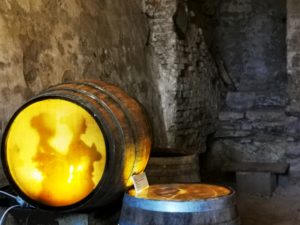
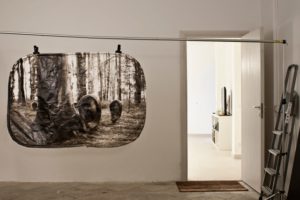
Rosa Mundi
In 2016 she was selected by the Polytechnic of Turin to exhibit in the Thetis art space at the 2016 Venice International Architecture Biennale at the Arsenale from May to November 2016 in the Gang City exhibition with her work Lupara al Borotalco. You also participate in the 2011 Venice Biennale of Contemporary Art.
Also in 2016, Rosa Mundi completes a major project written in 2009, namely a major interdisciplinary performance called BIAS – between Venice and Palermo – involving more than 77 artists from all over the world in the innovative concept of a transnational art biennial focused on spirituality of the artist, instead of the nationality or language he speaks. She exhibits at the RISO Museum – Palazzo Belmonte, in the Cathedral of Palermo, at Palazzo delle Aquile and in the Church of the Teatini. The BIAS (www.biasinstitute.it) is a biennial event that takes place mainly in Sicily, an island that the artist has chosen among his main inspiring lands and then opens up to many other places and historical cities between Europe, Asia, the East, Africa in the weeks following the inauguration.
Is the pseudonym of an artist behind whom lies the authentic soul of a complex philosophy of art, a mixture of anthropological and historical research with aesthetics. During her career Rosa Mundi has experimented with different forms of art, from the plastic and pictorial one, up to the photographic, performative and cinematographic one in an almost unstoppable journey towards the knowledge of herself and the world through her lens and its optical cone. It matters little whether he is a man or woman, of European or Middle Eastern origin, the color of his skin or the origin of his nationality, nor the image of his face reflected in the back of his works, what matters for Rosa Mundi it is the introspection and the human artistic reworking of his gaze on the world.
Since 1993 the artist has decided to operate with a fictional name, capable of enclosing and conveying his main essence as an artist, which looks at the world and at the events that follow one another with the constant amazement that precedes the blossoming of a rose.
A pseudonym capable of containing both the aesthetics and the scent of art, its immanent being and an essential element of the civilizations of all times and of all peoples. Aware of the difficulty of freeing oneself from the cultural relativism of which each individual, even unwittingly is a bearer, the artist chooses not only to name himself but also to operate, the Latin language as well as Aramaic and ancient Greek, better defined dead languages.
Rosa Mundi, in the main attempt to give it new vital lymph, places dead languages, devoid of a living civilization that practices them, at the center of her work, giving them a universally temporal role that contains within it an idea of linguistic spatial concept .
Within Rosa Mundi’s works, through the use of ancient natural fluorescent techniques, traces of the knowledge preserved in the work can often be seen. His reflections are in fact hidden among the meshes of his works, within them. The verb kept in the womb of his art, in addition to giving a strongly spiritual connotation to the meaning of the same, has the dual function of repositioning the work in the heart of human thought, i.e. the word and the infinite possibilities of being interpreted and / or associated. . Rosa Mundi creates art and verb at the same time, leaving inside it a clue and the key to knowledge only to the keeper, collector of her works, creating an indissoluble and temporal link between the artistic creation and the holder of the work itself over time .
The rarefaction of the limits of a nationalistic vision of art, promoted by the artist, then taken to the extreme, became in the last 15 years one of Rosa Mundi’s main proving grounds, prompting the artist in 2009 to develop a new concept of Biennial of Contemporary Art or BIAS (www.biasinstitute.it), the first transnational biennial of contemporary art in which artists are called to participate, freeing themselves from nationalistic cataloging preferring, among the possible, the association with spiritual paradigms linked to essence of the artist in his relationship to the world. The BIAS, as a sort of call to “arms”, a sort of great collective performance (as some artists have defined it) was conceived by the artist as a large abstract platform, a sort of non-place philosophically speaking, in which everyone the artists of the world can take the opportunity to dig in their own artistic experience the inspiring canons of their own creation and their place in the universe in the era of globalization, of Cyber space, of the opening of borders.
The BIAS is, as already coined by the artist in 2010, art now despite the awareness of being the daughter of a cycle that has now ended, magnificently represented by the Venice Biennale, the strong point of the historicization of contemporary art, a fixed point of the apparent end of “municipal” wars that have afflicted humanity from the first millennia BC to the Second World War.
Rosa Mundi has lived in various European cities, in the Mediterranean area and in the Middle East, and constantly feels the need to experiment and experiment, but she has lived in particular between two cities of water, a natural element that, among the four empedoclei , fully represents its ability to remodel and revitalize. Multifaceted artist, tireless traveler, through writings, photographs, videos, mixed media installations, she creates forms always poised between the phenomenal, real, and the imaginative, metaphysical world.
His creativity is a constant dialectic between social investigation and transcendent tension, immersed in a light that is now melancholic, now triumphal, in search of the infinite and the non-limit of the limit.
He attended the Academy of Fine Arts in Venice, the Academy of Fine Arts in Strasbourg, he was
She was born at the intersection of the coordinates 5 ° 26’23 ” Noth and 12 ° 19 ’55” East. Is an artist’s pseudonym. She lives between two European Islands, the location of which the artist wants to keep as a secret. A tireless traveler, dedicated to art and photography, and later video art, over twenty years, she transposes into art and artistic phenomena real events of everyday life and environmental phenomena. She uses different media, from photography, by reinterpreting it in an imaginative constant dialogue between reality and imagination, including complex installations made of textiles, plexiglass, iron, steel, wooden structures. She attended Painting, Sculpture, Choreography and Art History classes at the Academy of Fine Arts in Venice, the Academy of Fine Arts in Strasburg, the Ecole Martenot in Paris. Over the past 20 years she has exhibited in Strasbourg, in Venice, in Paris, in Deauville, in Vimoutiers, in Canapville, in Neuilly sur Seine, in Palerme, in Salemi (Trapani), in Castelporrona (Grosseto), in Montecarlo (Lucca), in Siena. In 2016, she was selected by the Politecnico of Torino to exhibit at Thetis Art Space at the International Architecture Biennale in Venice; furthermore, she exhibited her work “Lupara to Borotalco” at the Venice Arsenale (from May to November 2016) in the exhibition Gang City. She also participated in the Contemporary Art Biennale in Venice in 2011. Moreover, in 2016 Rosa Mundi completed a large project written in 2009, consisting in a huge interdisciplinary performance named BIAS – in both Venice and Palermo – involving more than 77 artists from all over the world in an ‘innovative concept of transnational Biennale focused on the artist’s spirituality, instead of on the nationality or language they speak’. She also exhibited at the Museum RISO – Palazzo Belmonte, in the Palermo Cathedral, the Palace of the Eagles and the Theatiner Church. In November 2016, at the Morsasco Castle, she held a solo exhibition of photos entitled “The Stone”, sponsored by Ace Castles and the Piedmont Region. In September 2016, she attended the international exhibition in Helsinki Finnish called Piexelache, with a video installation titled Virtual Mapping ADMID Animals Morph Empathic Phisiognomy, on the theme of empathy, reworking the principles of the darkroom by Gian Battista La Porta. Since February 2016, she has been co-working with Dimora Oz. In 2015, she exhibited at Palazzo Monte di Pieta in Palermo, at the exhibition entitled ‘Sicily – The Face of Humanity’, sponsored by ABI, an exhibition which travelled around the headquarters of some Italian banks. In 2015, she co-directed and started writing the screenplay of the film ‘The Other Side of Corleone’. In 2009, she wrote the historical philosophical novel ‘The Bestiary in the Rose Garden’, based on the Neoplatonism of Pico della Mirandola. In 2014, she exhibited in the group exhibition ‘The Power of Diversity’ – for UNESCO DESS, inside the Church of the Three Kings, at Serpotta, in Palermo, a city under nomination for inscription on the World Heritage List
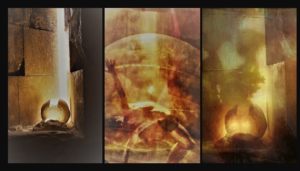

The most recent exhibitions
2018 | Judas the guess coreography Teatro Messina | Sicily Italia
2018 | Judas the guess Coreography in the Greek Roman Amphitheater of Tindari | Sicily Italia
2018 |Judas the guess Coreography in the Temple of Era in Selinunte | Sicily
2018| Exposition in in Baglio Florio Parco Archeologico di Selinunte curated by Enrico Caruso
2018 | Exposition in Museo delle Trame Mediterranee Fondazione Orestiadi | Baglio di Stefano curated by Enzo Fiammetta
2018 | Museo Arte Contemporanea Regione Sicilia Palazzo Belmonte Riso a cura di Valeria Li Vigni
2018 | Palazzo Alliata di Villafranca a cura di Gincamillo Custozza; BIAS Padiglione Esoterico Chiesa del Protomartire Palermo a cura di Franca Mollo
2017 | Mostra Personale Alessandria Castello di Morsasco Humanity’s Time Life by Guido Brivio
2017 | Artist guest and exposition in Biennale Arte Donna di Trieste
2017 |54ma Biennale Arte di Venezia, Algiubagiò Garden Mostra Collettiva Preview BIAS 2018 evento collaterale by Michela Sichera e Fabio Armao
2017 |Palermo, Collettiva Spazio Dimora OZ Trame dell’Intelletto by Andrea Kantos
2017 |Egitto penisola del Sinai Nuweba | Ras Saitan Progetto interattivo performante Portability con la Comunità dei Beduini by Lorena Rancati and Sarita Marchesi
2017 |Pietralia Soprana Museo del Sale Biennale del Sale La Graphomane Performance e Istallazione scultorea by Alba Romano Pace
2016 | Venezia 15ma Biennale Architettura di Venezia, Spazio Thetis Lupara al Borotalco by Gang City del Politecnico di Torino
2016 | Helsinki Pixelache Festival Art Virtual Mapping Admin Animals Morph Empathic Phisiognomy by Eggle Oddo e Pixelache commission
2015 Co-Worker di Dimora OZ
2014 |Palermo Palazzo Monte di Pietà Personale Il Volto di una umanità, by ABI associazione banche italiane
2014|Palermo Museo Belmonte Riso e Chiesa dei tre Re Collettiva The Power of Diversity, Collettiva by UNESCO DESS.
Rosa Mundi call in
HUMANITY’S TIME LIFE Rosa Mundi video art 2010- 2018
Photographer, Video Editor and Director Rosa Mundi
Music Editor BJM Mario Bajardi
Trip Fragment to Palmyra
Tracks: Officium 1 DVA – Officium 3
Taken from “Schengen” Album 2017
Courtes by ONDE Elettronic contents 2017
Published by Iter – Research 2017
You thanks the Regina Zenobia that it dared to rebel to the Empire Romano, to Cleopatra, to Didone and Semiramide, St. Simeone Stilita the Old one and to the Archaeologist Khaled Asaad.
You thanks the humanity of Palmyra She Marries some desert, to the waters of the river Euphrates, the long Palms that encircled his/her course, the humanity of the Krak des Chevaliers, Qalʿat Ṣalāḥ al-Dīn , the ruins of the Fortress of Simeone Qal.at Sim.an, to the humanity of the temple of Baalshamin, to the humanity of the temple of Baal.
Palmyra, the city of palms, was the name of an ancient city of Syria, destroyed by the Arabs in the 6th century. It was an important caravan center on the Euphrates River, in the Syrian desert, where welfare and wealth were at everyone’s reach. The kingdom of Palmyra dates back to 267 BC. It was a place of tolerance, a crossroad of religions that lived together freely. Bet – Zabbai, the Aramaic name of Zenobia, means Zabbai’s daughter. In the Historia Augusta, she was represented as a chaste, charismatic, attentive and generous Queen who did not hesitate to take part in battles with his soldiers, either on horseback or on a chariot. Zenobia was very educated, she spoke Aramaic, Egyptian, Greek and Latin and nourished her court of intellectuals and philosophers. She wanted autonomy from the Roman Empire and wanted to gather under her kingdom Asia Minor and Egypt. She succeeded in stealing Arabia from the Romans with the help of the Parties. But in 272 a.c. she had to surrender to Rome Caput Mundi.
Today the city of Palmira, Syria, is the symbol of a conflict that has lasted since March of 2011, gives of an apparent revolt against the President Bashar Assad, actually to that moment praised representative of a sure and secular State, a sort of safety pad of the doors of the heat middle East.
A camouflaged civil war, disclosed then him in the scientific fury Jihadista and in the destroying violence of the men than to the Al Qaeda, that today reveals him and it is delineated without more border than doubt, a war on the field among two different aces: the monarchies of the Gulf, Turkey and the same United States to which the intervention of Iran and the militias is contrasted Lebanese sciite of Hezbollah beside Assad. The war doesn’t save anybody, it strikes above all the civilians daily causing slaughters and the massacres.
The media and the international politics seemed definite to dismiss the President Assad when September 30 th 2015 Russia has intervened supporting the troops of Damask. The scenery is complicated.
Today in Syria a war is fought for proxy where the principal involved powers. regional and world – the people use – the humanity of Palmira of the XXI symbol – as of the pedines, unintentional fighters.The victims’ number, according to the sirian observatory , is in continuous increase: 312.000 corpses 149.000 civilians 16.000 children and thousand of fugitive. Numbers destined to increase every day that passes.
The fugitive ones of passage, the humanity in transit – The Passengers – they are stolen of their daily life, unaware keepers of the testimonies of a glorious past, people is used as shield of archaeological sites that make to shiver the international community, are forced to escape and to cross the Door. The Door – to abandon everything, to slip in the dark of an unknown future and to jump in the void. The Jump – of the Mare Internum Nostrum
Rosa Mundi “I’M HERE, DEATH SMELLS OF RESURRECTION” TRASFORMATORIO 2018 Città di GIAMPILIERI (MS)
HUMANITY’S TIME LIFE Rosa Mundi video art 2010- 2018
Photographer, Video Editor and Director Rosa Mundi
Music Editor BJM Mario Bajardi
Trip Fragment to Palmyra
Tracks: Officium 1 DVA – Officium 3
Taken from “Schengen” Album 2017
Courtes by ONDE Elettronic contents 2017
Published by Iter – Research 2017
You thanks the Regina Zenobia that it dared to rebel to the Empire Romano, to Cleopatra, to Didone and Semiramide, St. Simeone Stilita the Old one and to the Archaeologist Khaled Asaad.
You thanks the humanity of Palmyra She Marries some desert, to the waters of the river Euphrates, the long Palms that encircled his/her course, the humanity of the Krak des Chevaliers, Qalʿat Ṣalāḥ al-Dīn , the ruins of the Fortress of Simeone Qal.at Sim.an, to the humanity of the temple of Baalshamin, to the humanity of the temple of Baal.
Palmyra, the city of palms, was the name of an ancient city of Syria, destroyed by the Arabs in the 6th century. It was an important caravan center on the Euphrates River, in the Syrian desert, where welfare and wealth were at everyone’s reach. The kingdom of Palmyra dates back to 267 BC. It was a place of tolerance, a crossroad of religions that lived together freely. Bet – Zabbai, the Aramaic name of Zenobia, means Zabbai’s daughter. In the Historia Augusta, she was represented as a chaste, charismatic, attentive and generous Queen who did not hesitate to take part in battles with his soldiers, either on horseback or on a chariot. Zenobia was very educated, she spoke Aramaic, Egyptian, Greek and Latin and nourished her court of intellectuals and philosophers. She wanted autonomy from the Roman Empire and wanted to gather under her kingdom Asia Minor and Egypt. She succeeded in stealing Arabia from the Romans with the help of the Parties. But in 272 a.c. she had to surrender to Rome Caput Mundi.
Today the city of Palmira, Syria, is the symbol of a conflict that has lasted since March of 2011, gives of an apparent revolt against the President Bashar Assad, actually to that moment praised representative of a sure and secular State, a sort of safety pad of the doors of the heat middle East.
A camouflaged civil war, disclosed then him in the scientific fury Jihadista and in the destroying violence of the men than to the Al Qaeda, that today reveals him and it is delineated without more border than doubt, a war on the field among two different aces: the monarchies of the Gulf, Turkey and the same United States to which the intervention of Iran and the militias is contrasted Lebanese sciite of Hezbollah beside Assad. The war doesn’t save anybody, it strikes above all the civilians daily causing slaughters and the massacres.
The media and the international politics seemed definite to dismiss the President Assad when September 30 th 2015 Russia has intervened supporting the troops of Damask. The scenery is complicated.
Today in Syria a war is fought for proxy where the principal involved powers. regional and world – the people use – the humanity of Palmira of the XXI symbol – as of the pedines, unintentional fighters.The victims’ number, according to the sirian observatory , is in continuous increase: 312.000 corpses 149.000 civilians 16.000 children and thousand of fugitive. Numbers destined to increase every day that passes.
The fugitive ones of passage, the humanity in transit – The Passengers – they are stolen of their daily life, unaware keepers of the testimonies of a glorious past, people is used as shield of archaeological sites that make to shiver the international community, are forced to escape and to cross the Door. The Door – to abandon everything, to slip in the dark of an unknown future and to jump in the void. The Jump – of the Mare Internum Nostrum
La graphomane
ἰδὲ γὰρ ἀνθρώπους οἷον ἐν καταγείῳ οἰκήσει σπηλαιώδει, ἀναπεπταμένην πρὸς τὸ φῶς τὴν εἴσοδον ἐχούσῃ μακρὰν παρὰ πᾶν τὸ σπήλαιον, ἐν ταύτῃ ἐκ παίδων ὄντας ἐν δεσμοῖς καὶ τὰ σκέλη καὶ τοὺς αὐχένας, ὥστε μένειν τε αὐτοὺς εἴς τε τὸ πρόσθεν μόνον ὁρᾶν, κύκλῳ δὲ τὰς κεφαλὰς ὑπὸ τοῦ δεσμοῦ ἀδυνάτους περιάγειν, φῶς δὲ αὐτοῖς πυρὸς ἄνωθεν καὶ πόρρωθεν καόμενον ὄπισθεν αὐτῶν, μεταξὺ δὲ τοῦ πυρὸς καὶ τῶν δεσμωτῶν ἐπάνω ὁδόν, παρ᾽ ἣν ἰδὲ τειχίον παρῳκοδομημένον, ὥσπερ τοῖς θαυματοποιοῖς πρὸ τῶν ἀνθρώπων πρόκειται τὰ παραφράγματα, ὑπὲρ ὧν τὰ θαύματα δεικνύασιν (La Repubblica di Platone VII 514 a – b)
Biennale del Sale | Pietralia Soprana – Sicily 2017
